Finding Balance.
May 31, 2022
A herd of female white-tailed deer
The most dangerous wild animal in Pennsylvania has caused 69 deaths and 6,208 injuries in the past five years. It’s ruining crops, damaging future timber harvests, and changing the state’s forest composition.
It’s not the black bear, bobcat, or wild boar. It’s the official state animal of Pennsylvania: the white-tailed deer.
And humans made it so.
Unlike other species whose escalating populations upset ecological balance, Odocoileus virginianus is a native to the United States. A combination of human forces—killing of deer’s natural predators, destruction of forest habitat, and a warming climate—has created a three-fold increase in the number of deer in Pennsylvania in the last 350 years.
Prior to European colonization, deer were in balance with their forest habitat, according to experts from The Pennsylvania State University. The land we now call Pennsylvania had an estimated eight to 10 deer per square mile. (For reference, a square mile is 640 acres.) For thousands of years, Native peoples kept deer populations in check through hunting. Large predators—such as mountain lions, bears, and wolves—were an added control.
All of that changed within a relative instant with the arrival of settlers from across the Atlantic. Unlike the European system—where landowners controlled who hunted their properties and how many animals were killed—anyone could hunt wildlife because it was considered common property. And hunt they did. By the end of the 1800s, only an estimated 500 deer remained in Pennsylvania.
In 1895, the Pennsylvania Game Commission was formed to protect the state’s wildlife resources—namely black bear, beaver, wild turkey, elk, and white-tailed deer. The commission established game lands, brought in deer from other states, and lobbied state government to enact legal restrictions.
The deer population rebounded quickly. Today, Pennsylvania is home to an estimated 1.5 million white-tails, according to the state Game Commission. That’s about 32 deer for every square mile.
“High deer populations in most of Pennsylvania have greatly altered forest understories,” stated Roger Latham, Ph.D., an ecologist and conservation biologist with Continental Conservation and a former member of Natural Lands’ Board of Trustees. Latham has authored numerous reports on the ecological impact of deer. “To the casual observer the woods still look green, but they are much altered. In place of the diverse, multi-storied vegetation that was the norm, there are just a few species, either not preferred by deer or resilient to repeated browsing.”
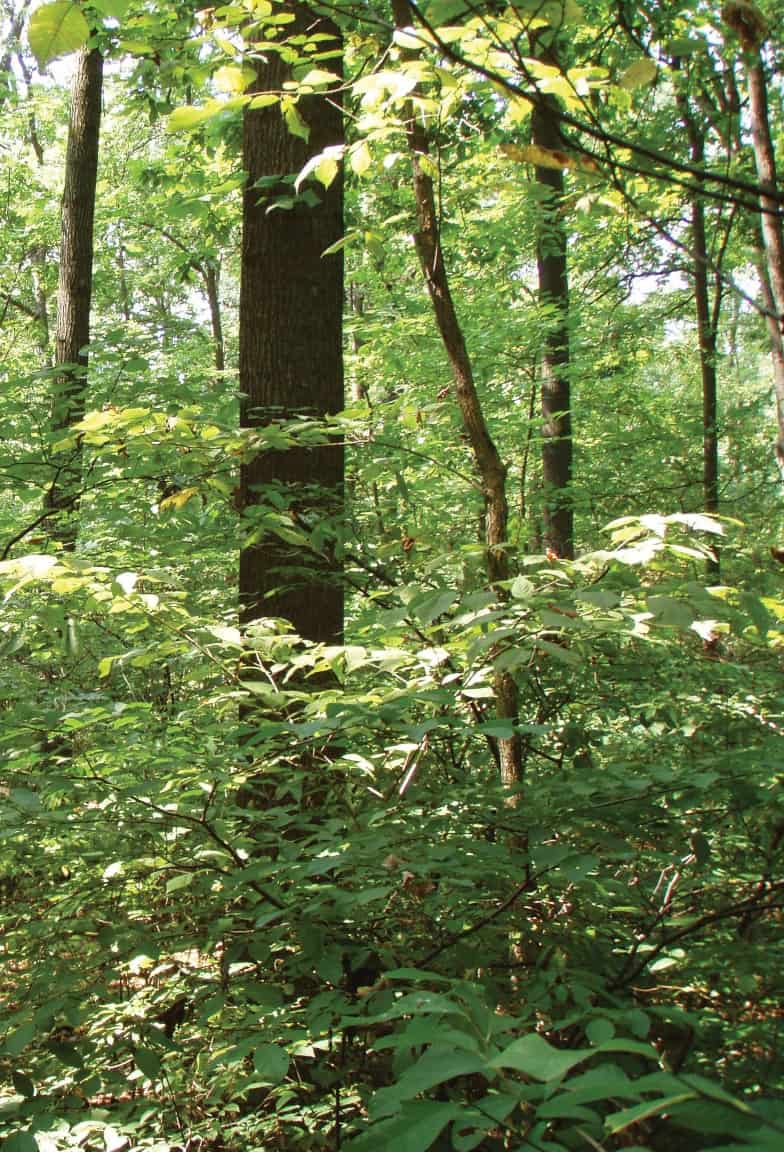 a healthy forest |
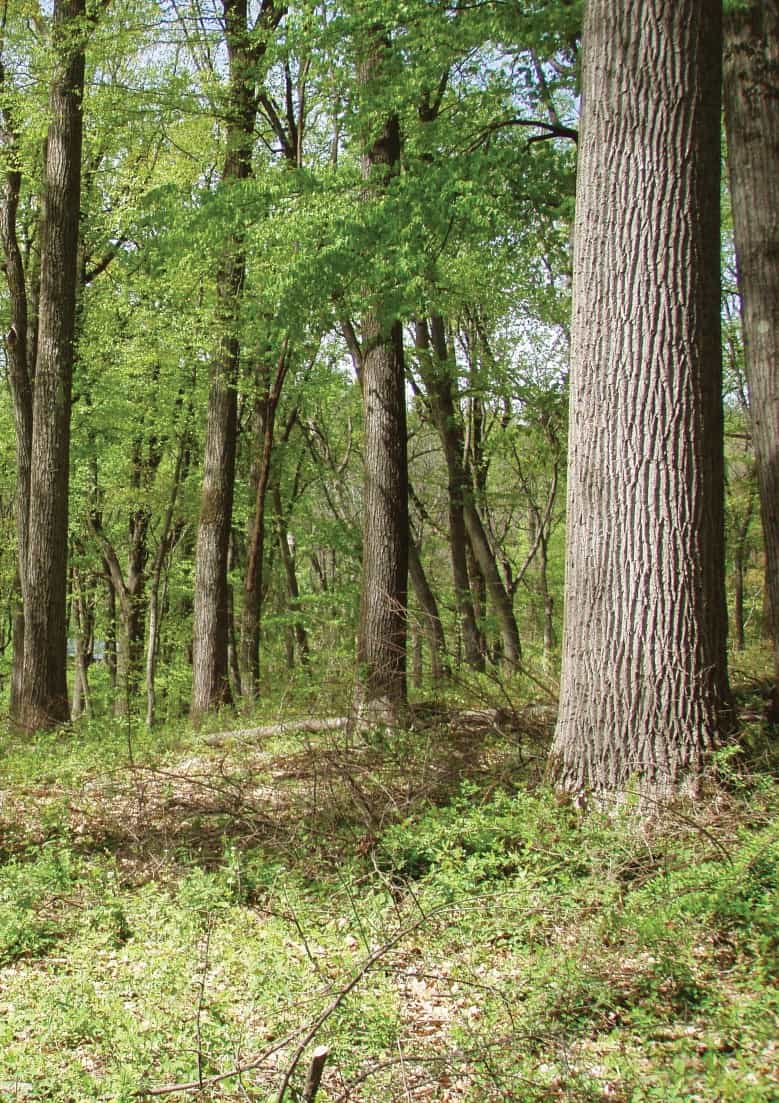 a degraded forest |
Of course, deer populations impact more than just the forest and its flora and fauna. When our woodlands aren’t in balance, they can’t support the insects that make life possible. The loss of native plants and trees means caterpillars have no food to eat. Fewer caterpillars mean songbirds can’t feed their young. And the ripples continue through the interconnected web of which we humans are a part.
Deer overpopulation impacts human health more directly, too. White-tailed deer are an important reproductive host for adult black-legged ticks, which transmit an array of diseases to humans, including Lyme disease.
Pennsylvania has the highest rate of Lyme disease in the country, with Chester County ranking top in the state. Symptoms include fever, headache, fatigue, and a characteristic bull’s-eye rash. If not treated, the infection can spread to joints, the heart, and the nervous system.
Last year, nearly 40 percent of ticks tested positive for Lyme disease in the largest study every conducted in Pennsylvania. As climate change brings milder winters that favor tick survival, Lyme disease is now a year-round threat. There were more cases in 2020 than in recent years due to pandemic-spurred interest in hiking and other outdoor activities.
And the impact extends to our roadways. Last year, 5,586 car crashes were caused by deer, according to the Pennsylvania Department of Transportation, resulting in 1,250 injuries and 19 deaths.
“The bottom line is that humans have been manipulating the deer population—and by extension the ecosystem—for thousands of years,” said Tim Burris, Natural Lands’ wildlife management coordinator and preserve manager at Mariton Wildlife Sanctuary in Easton, PA. “Ironically, to keep from losing our forests, we are now compelled to continue the manipulation. A long-term controlled hunting program is the best tool at our disposal for doing that.”
Tim has overseen Natural Lands’ successful hunting program for nearly 30 years. Hunters must apply to participate in the program, complete regular training and proficiency testing, and comply with strict safety protocols. The program emphasizes the removal of does as the best way to reduce and maintain populations at our nature preserves.
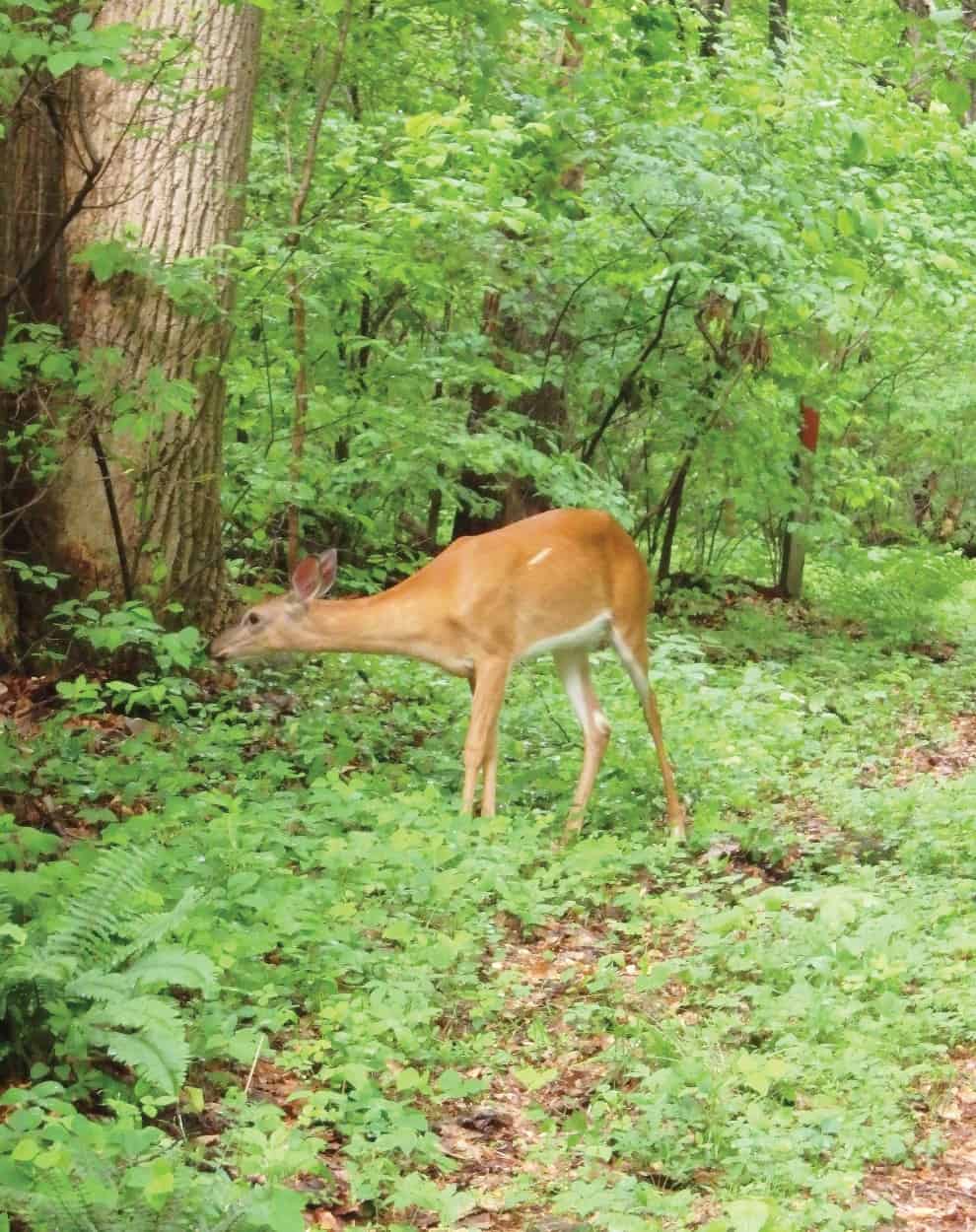
Photo by Tim Burris
Tim says that he doesn’t try to estimate the number of deer on Natural Lands’ properties. “Measuring their impact is actually a more practical way to assess the effectiveness of hunting year over year. We follow a five-level deer impact index established by the U.S. Forest Service and Penn State University.”
Over the decades, Tim and other members of our land stewardship team have noted improvements in forest health. “Of course, we don’t rely on hunting alone to safeguard our forests,” said Tim. “We use tree tubes to protect the tree seedlings we plant. We are always working to remove invasive plants and re-establish native species. We know we can’t just sit back and let nature ‘take its course’ because we altered that course generations ago.”
Natural Lands’ Reineman Preserve in Carlisle, PA, is an instructive example of why inaction is not an option. The original donor stipulated no hunting at the 3,200-acre property. With more than 100 deer per square mile, there is a total lack of understory vegetation. Canopy trees of oak, hickory, and beech drop their seeds only to have them all consumed by deer, preventing germination. As these remaining trees die, more sunlight penetrates to the forest floor where a carpet of invasive Japanese stiltgrass thrives, unpalatable to deer. The forest at Reineman is a jarring combination of tall trees and low, green grass, with nothing in between.
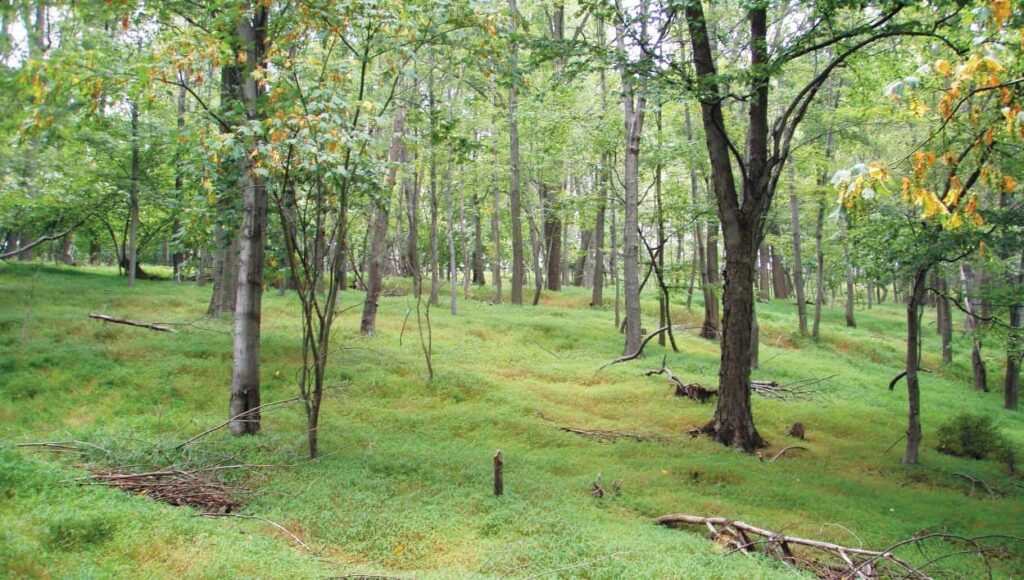
With 100 deer per square mile, Reineman Preserve is a jarring combination of tall trees and low, green grass, with nothing in between.
Photo by David Steckel
Biologists at nearby Dickinson College have confirmed the complete absence of tree seedlings and the future for this forest if deer roam unchecked: it will gradually degrade into an impoverished savanna, unable to sustain life beyond invasive species.
Even the deer causing this destruction will not be able to survive there.
So—when you visit your favorite preserve or state park this fall and read signs indicating that controlled hunting occurs there—know that this activity is essential to forest health. It is, however ironically, a key to white-tailed deer survival as well.
missing predators.
In the 1800s, hunters and trappers killed native gray wolves to extirpation. The last-known Pennsylvania wolf was killed in 1892, wiping out an important apex predator capable of keeping deer populations in check.
The state supports a thriving population of eastern coyotes, with some exceeding 50 pounds. They don’t pursue prey in packs the way wolves do, which limits their effectiveness as deer predators.
Although they are occasionally reported by hikers in remote locations, the U.S. Fish and Wildlife Service thinks the eastern cougar—also known as mountain lion—was probably wiped out of the eastern United States in the 1930s. Also on the extirpated list are lynx and wolverines.
Black bears take more fawns in Pennsylvania than any other predator, according to a study released in 2018 by the PA Game Commission and Penn State.
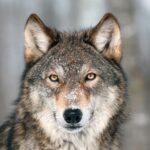 Gray wolf |
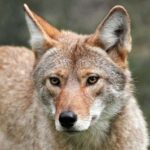 Eastern coyote iStockphoto.com-karlumbriaco |
 Eastern coyote |
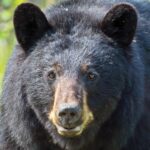 Black bear |
minding the gaps.
Managing deer populations through controlled hunting is just one way Natural Lands fills in gaps in our ecology—gaps created by humans long ago. At our nature preserves we are the wolves, the bison, the elk, the hollow trees, and more.
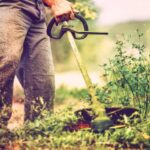 iStockphoto.com-egon69 |
Fulshaw Craeg Preserve in Montgomery County is home to a number of rare and endangered species, including native showy goldenrod. This plant needs routine disturbance for its wind-dispersed seeds to germinate. In the absence of wood bison, a massive animal that roamed the eastern U.S. before its extinction, we mimic a grazing effect with string trimmers. |
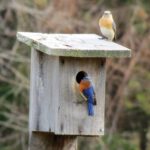 Photo by Carole Mebus |
We have installed more than 500 nest boxes at our preserves to attract Eastern Bluebirds and American Kestrels. These two very different native species share a preference for nesting in hollow tree cavities. As natural areas—and the decaying trees found there—are developed, these birds depend increasingly on man-made boxes in which to build their nests. |
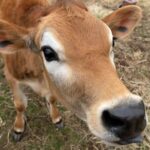 Photo by Mae Axelrod |
Natural Lands has planted thousands of tree seedlings over the decades to improve forest and stream-edge habitat. But sometimes we want to prevent tree growth to favor a small, highly endangered species: the bog turtle. At one of our Chester County preserves, we use cows to trample woody plants and disturb the mucky soil these turtles favor. The cows fill in for services once provided by wood bison and elk.
|
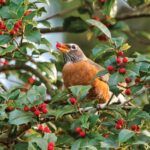 Photo by David Korbonits |
At Stoneleigh: a natural garden, we recently finished the installation of a 10-foot-wide wildlife hedge to replace one composed only of eastern hemlock. “We wanted to expand the species in the hedge composition to mimic the diversity found in a healthy forest,” said Ethan Kauffman, director of Stoneleigh. “This feature is beneficial to wildlife and its diverse plantings make it more resilient to blight and disease.” |
next post
Of Kestrels And Cows.
May 31, 2022
Kestrels are North America’s smallest and most colorful falcons. Once a common sight in our region, they have declined more than 80 percent in the […]
continue reading